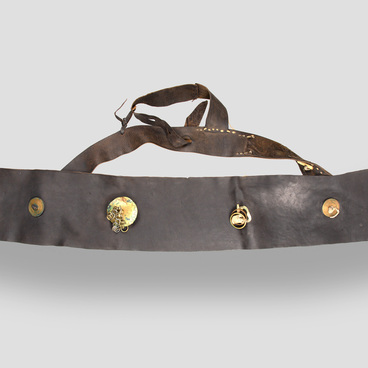Shamanism is an ancient world religion practiced in Siberia. It embraced a belief in spirits and an interactor’s power to communicate with them. This type of worldview led people to assume that all things — animate and inanimate — possessed a spirit, and that an idol was able to bring good or bad luck. The peoples of Western Siberia communicated with the spirits through their shamans, the most important people of the ancient society.
The word “shaman” came from the Manchu-Tungus languages. The word is formed from the verb “ša” meaning “to know”. People believed that shamans knew more than everyone else. Shamans had different ranks and skills, but all of them were distinguished by bright unusual costumes, masks and sacred objects. The drum was one of the shaman’s most important attributes.
The shaman used a drum for rituals: with its help, he went into trance and summoned spirits. The peoples of the Russian North believed that the drum symbolized a deer on which the shaman could travel on the ground, rise into the sky and descend into the underworld. For some shamans, the drum was a boat or a bird when they needed to overcome a water or fire barrier. The drum was made according to the instruction of the patron spirit, who appeared to the shaman in a dream and told how the instrument was to be made.
It was forbidden to use a brand new drum for performing a ritual in a state of trance. The instrument was first to be “brought to life” — it had to receive all the shamanic properties. During the ritual of bringing the drum to life, the shaman’s tribesmen acted as if they were pursuing a wild deer. After that, the drum became a sacred object, but it could only belong to a shaman who had been initiated and studied with the master for several years.
The ritual in a state of trance (“kamlanie’) was carried out in a chum (a tent) at any time of the day. The guests sat on the floor, the shaman sat down on a deer skin near the fire, took a mallet and started to beat the drum. Only the shaman had the right to touch the instrument. The Nenets and Selkups believed that spirits severely punished those people who would violate the rules of interacting with the otherworld.
The size of the drum depended on the shaman’s power and age. Drums could be more than half a meter in diameter and not always perfectly round. The frame was made of softwood (larch or cedar) with fresh, soft buckskin stretched on top. The tradition of making shamanic drums was passed down from generation to generation.
The word “shaman” came from the Manchu-Tungus languages. The word is formed from the verb “ša” meaning “to know”. People believed that shamans knew more than everyone else. Shamans had different ranks and skills, but all of them were distinguished by bright unusual costumes, masks and sacred objects. The drum was one of the shaman’s most important attributes.
The shaman used a drum for rituals: with its help, he went into trance and summoned spirits. The peoples of the Russian North believed that the drum symbolized a deer on which the shaman could travel on the ground, rise into the sky and descend into the underworld. For some shamans, the drum was a boat or a bird when they needed to overcome a water or fire barrier. The drum was made according to the instruction of the patron spirit, who appeared to the shaman in a dream and told how the instrument was to be made.
It was forbidden to use a brand new drum for performing a ritual in a state of trance. The instrument was first to be “brought to life” — it had to receive all the shamanic properties. During the ritual of bringing the drum to life, the shaman’s tribesmen acted as if they were pursuing a wild deer. After that, the drum became a sacred object, but it could only belong to a shaman who had been initiated and studied with the master for several years.
The ritual in a state of trance (“kamlanie’) was carried out in a chum (a tent) at any time of the day. The guests sat on the floor, the shaman sat down on a deer skin near the fire, took a mallet and started to beat the drum. Only the shaman had the right to touch the instrument. The Nenets and Selkups believed that spirits severely punished those people who would violate the rules of interacting with the otherworld.
The size of the drum depended on the shaman’s power and age. Drums could be more than half a meter in diameter and not always perfectly round. The frame was made of softwood (larch or cedar) with fresh, soft buckskin stretched on top. The tradition of making shamanic drums was passed down from generation to generation.






